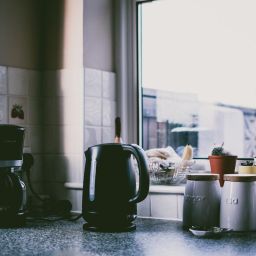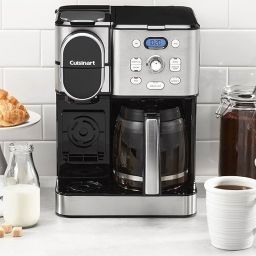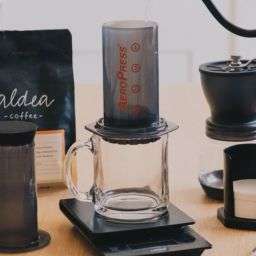
Slow drip coffee makers, often referred to as Kyoto-style coffee brewers, are a unique and elegant addition to the world of coffee making. Originating from Japan, these devices are celebrated for their meticulous brewing technique which involves cold water dripping slowly over coffee grounds. This method not only preserves the delicate flavors of the coffee but also enhances the overall sensory experience, making it a favorite among coffee connoisseurs who cherish a refined brew.
Key Takeaways for Slow Drip Coffee Makers
- Gentle Extraction Process: The slow drip method is gentle, allowing the water to extract flavors gradually, which minimizes bitterness and brings out the natural sweetness in the coffee.
- Flavor Enhancement and Reduced Acidity: This brewing technique enhances the coffee’s inherent flavors and significantly reduces its acidity, resulting in a smoother cup that’s easy on the stomach.
- Importance of Coffee Bean Selection and Grind Consistency: Selecting the right coffee beans and grinding them to the correct consistency are crucial for achieving the best results. Medium to coarse grinds work best with slow drip coffee makers.
- Overview of Common Setups and Components: A typical slow drip coffee maker consists of three main parts: the water reservoir, the coffee chamber, and the collection carafe. Mastery over each component’s setup and maintenance is key to consistently great coffee.
Essential Components of a Slow Drip Coffee Maker
Understanding the essential components of a slow drip coffee maker is key to mastering this elegant brewing method. Let’s break down the three main parts: the water chamber, coffee chamber, and collection chamber.
Water Chamber: This is where the brewing process starts. The water chamber is typically filled with cold, clean water which drips slowly onto the coffee grounds. The drip rate can often be adjusted to affect the strength and flavor of the brew.
Coffee Chamber: Here, the coffee grounds are held. It’s crucial that the coffee is ground to a medium to coarse texture to ensure optimal extraction. The coffee chamber should allow for even water distribution over the grounds to prevent channeling, where water bypasses some of the coffee.
Collection Chamber: Below the coffee chamber, the collection chamber catches the slowly brewed coffee. This part of the maker should be designed to prevent any contamination from previous brews and maintain the purity of the flavor.
When it comes to filters, you have two main choices: paper or metal. Paper filters are excellent for achieving a cleaner cup of coffee, removing most of the coffee oils and fines. On the other hand, metal filters allow more oils and fines to pass through, which can enhance the body and flavor complexity of the coffee but might leave some sediment.
Choosing the Right Coffee Beans
Selecting the right coffee beans is crucial for making exceptional slow drip coffee. The choice between single-origin and blended beans plays a significant role in the flavor profile of your brew.
Single-Origin Beans: These come from one specific location or farm. They are prized for their unique flavor characteristics which reflect their growing environment. Single-origin beans can provide a distinct and memorable taste experience, making them ideal for those who want to explore nuanced flavors.
Blended Beans: Blends combine beans from various origins. The goal is to create a balanced and consistent flavor profile that highlights the best aspects of each component bean. Blends are great for those who enjoy a coffee that maintains the same taste from batch to batch.
The roast level also affects the flavor of your slow drip coffee. Lighter roasts tend to offer brighter acidity and more nuanced flavor profiles, ideal for slow drip brewing, which can highlight these subtleties. Darker roasts provide bolder, more robust flavors but might overshadow some of the intricacies that slow drip brewing can reveal.
The Perfect Ratio and Grind Size
Achieving the perfect brew with a slow drip coffee maker starts with understanding the crucial coffee-to-water ratio and the ideal grind size. Here’s a breakdown to help you get started:
Coffee-to-Water Ratio: The ratio of coffee to water is fundamental in determining the strength and flavor of your coffee. For slow drip coffee, a common ratio is either 1:15 or 1:16. This means for every gram of coffee, you use 15 to 16 grams of water. Experimenting within these ranges can help you find your preferred balance between strength and flavor.
Grind Size: The grind size significantly affects the extraction process. For slow drip coffee makers, a medium to coarse grind is ideal. This size allows the water to flow at the right pace, extracting the desired flavors without pulling out undesirable bitter compounds. A grind that’s too fine can lead to over-extraction, while a grind that’s too coarse may under-extract, leading to a weak brew.
Brewing Technique and Setup
Setting up your slow drip coffee maker properly is the key to achieving the best results. Follow these steps to ensure you’re on the right track:
- Setup: Start by placing your filter—whether paper or metal—into the coffee chamber. Ensure it’s fitted well to avoid any grounds getting into the brew.
- Add Coffee: Measure your coffee grounds using a scale to ensure accuracy, and pour them into the filter. Make sure the grounds are evenly distributed to promote uniform extraction.
- Adjust Water: Fill the water chamber with cold, clean water. If your model allows, set the drip rate before starting the brew.
- Begin Brewing: Start the brewing process. The water should drip slowly over the grounds. The typical brew time for slow drip coffee can range from several hours to overnight, depending on your setup and drip rate.
Adjusting the Drip Rate: The drip rate is crucial in controlling the extraction. A slower drip rate means a longer extraction time, which can enhance the depth of flavor. However, if the drip is too slow, it might over-extract the coffee, making it bitter. Conversely, a faster drip rate can lead to under-extraction, producing a weaker brew. Adjust this setting based on your taste preferences and the specific characteristics of the coffee beans you’re using.
Maintenance and Troubleshooting
Keeping your slow drip coffee maker in top condition is essential for enjoying the best coffee and ensuring the longevity of your equipment. Here’s how to maintain your setup and troubleshoot common issues:
Regular Cleaning: After each use, dismantle your coffee maker and rinse each part with warm water. For the water and coffee chambers, use a soft brush to remove any residue. If your coffee maker has a metal filter, clean it thoroughly to prevent oil build-up, which can affect the taste of your coffee.
Descaling: Over time, mineral deposits from water can build up in your coffee maker, especially if you use hard water. To descale, fill the water chamber with a mixture of equal parts water and white vinegar and let it drip through the system. Rinse thoroughly with clean water afterward to remove any vinegar residue.
Troubleshooting Over-Extraction and Clogging:
- Over-Extraction: If your coffee tastes bitter, it might be over-extracted. This can be caused by a grind that’s too fine, a drip rate that’s too slow, or excessive brewing time. Adjust your grind to be coarser, increase the drip rate, or shorten the brewing time.
- Clogging: This often occurs if the coffee grounds are too fine or if there’s a buildup of coffee oils. To fix clogging, first, check if the grind size is appropriate (medium to coarse). Clean the filter and check for any residue that might be blocking the drip mechanism.
Check for Wear and Tear: Regularly inspect all components of your coffee maker for signs of wear and tear. Replace any parts that appear damaged or worn out to prevent leaks or inconsistent brewing.
FAQs
What is the optimal brew time? The ideal brew time can vary based on the volume of water and the grind size, but generally, it ranges from 6 to 12 hours. Experimenting within this range can help you find your preferred balance between flavor and strength.
How can I enhance the flavor of my coffee? To enhance your coffee’s flavor, consider adjusting the coffee-to-water ratio, experimenting with different grind sizes, and trying various drip rates. Also, using freshly roasted, high-quality beans can significantly improve the taste.
What are the best maintenance practices? Regular cleaning and descaling of your coffee maker are crucial. Use warm water and gentle detergents for cleaning, and descale with a vinegar solution every few months to prevent mineral buildup, which can affect the performance of your coffee maker.
Final Thoughts
Slow drip coffee makers offer a unique way to experience coffee, accentuating intricate flavors and producing a smoother, less acidic brew than traditional methods. The key benefits of using a slow drip coffee maker include enhanced flavor profiles and the joy of customization.
By experimenting with different beans, grind sizes, and ratios, you can tailor your brewing process to suit your taste perfectly. This method not only brews coffee but also invites you to engage deeply with the process, understanding and appreciating the subtleties of coffee brewing.








